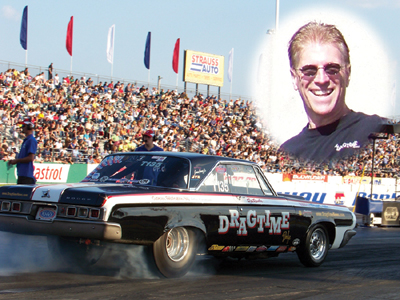| (Find
more More Bracket Racing 101 articles HERE)
 One
day last season I was having a conversation at Englishtown
with a fellow bracket racer. The racer had just lost an
early round, and I asked how the round went down. “My
opponent double-bulbed me, so I rushed to get in. I went
red.” One
day last season I was having a conversation at Englishtown
with a fellow bracket racer. The racer had just lost an
early round, and I asked how the round went down. “My
opponent double-bulbed me, so I rushed to get in. I went
red.”
Each
racer has their own routine and pacing when at the track.
Whether you like to get to the track early and unload with
time to spare, or arrive as cars are being called into the
lanes, whether you go up to the lanes at the first call
or you wait until the last, we all race within our own comfort
zones. However, because of all the different comfort zones
operating simultaneously at the track, we also need to be
adaptive when things don’t go the way we’d like.
After all, the ultimate goal isn’t having everything
go the way we’d like; it’s winning the race.
The adaptive racer will be in a better position to win rounds.
If you win enough of them, you’re winning the race.
Maybe keeping your pace won’t ensure a win, but losing
your pace won’t help.
In the
case of the racer cited above, she did not adapt to a difference
in pace. She allowed the pace of another racer to influence
her own pace, which took her out of her comfort zone. When
she told me what happened, my advice to her was to stop
her car as soon as she was double-bulbed, collect her thoughts
for a second, breathe, and run through the next steps in
her head so that her mind was ahead of the race.
I’ve
seen the same sort of thing happen in the lanes. Two racers
get paired up for a round, and one jumps in their car and
rushes up to the head of the lanes while the other driver
is still checking their tire pressure. Whether the first
racer is rushing things intentionally or not isn’t
the issue. That racer has every right to operate at their
own pace, but by the same token the second racer shouldn’t
all of a sudden feel rushed, possibly forgetting to check
the pressure in the other slick or even forgetting to write
the dial on the car in the process.
I witnessed
another example of rushing the pace recently at a big money
bracket race in the Northeast. As I waited for next round
I was at the starting line watching the tail end of the
current round. A racer who deep-stages pulled in to the
water box and waited for the previous pair to leave the
line and for the official to give the ‘go’ sign
to start the burnout (side-note: the rule at this race—which
mirrors the rule in NHRA Division 1—was that the word
“deep” could not appear on the car, and although
deep-staging was being permitted, the track would not honor
deep staging by holding the tree. If you were deep-staging
at this event and wanted to make sure the tree didn’t
come down on you, you had to rush in first). The racer cited
here did just that at the expense of checking his dial-in.
Sure enough the dial was wrong. Instead of the 10.53 on
his window, he was dialed at 10.43, a number he could never
run. Needless to say he lost that round. Had he been operating
at his own pace he would have caught the error and at least
would have been in the race.
Rushing
at one point can come back to bite you at a later point.
Case in point: dial-ins. Racers who are rushing have a tendency
to write their dial-ins almost illegibly. Then the tower
can’t read the dial as the car pulls past on the way
to the water. As the official in the tower is getting out
the binoculars to see the car better, it’s now enveloped
in burnout smoke. Then the racer is pulling up to the line,
and their dial still isn’t up on the boards. If they
stage now, they might be accepting an incorrect dial, just
like the racer cited above. Unlike his example, all this
would have been avoided if the racer had taken the time
to write the dial clearly while still in the lanes, and
then paused at the point closest to the tower so they could
make sure to get it right.
Take
your time, breathe, keep your mind ahead of the race and
go through your routine as carefully and deliberately as
possible. Winning rounds is hard enough as it is; don’t
make it harder than it has to be.
|



